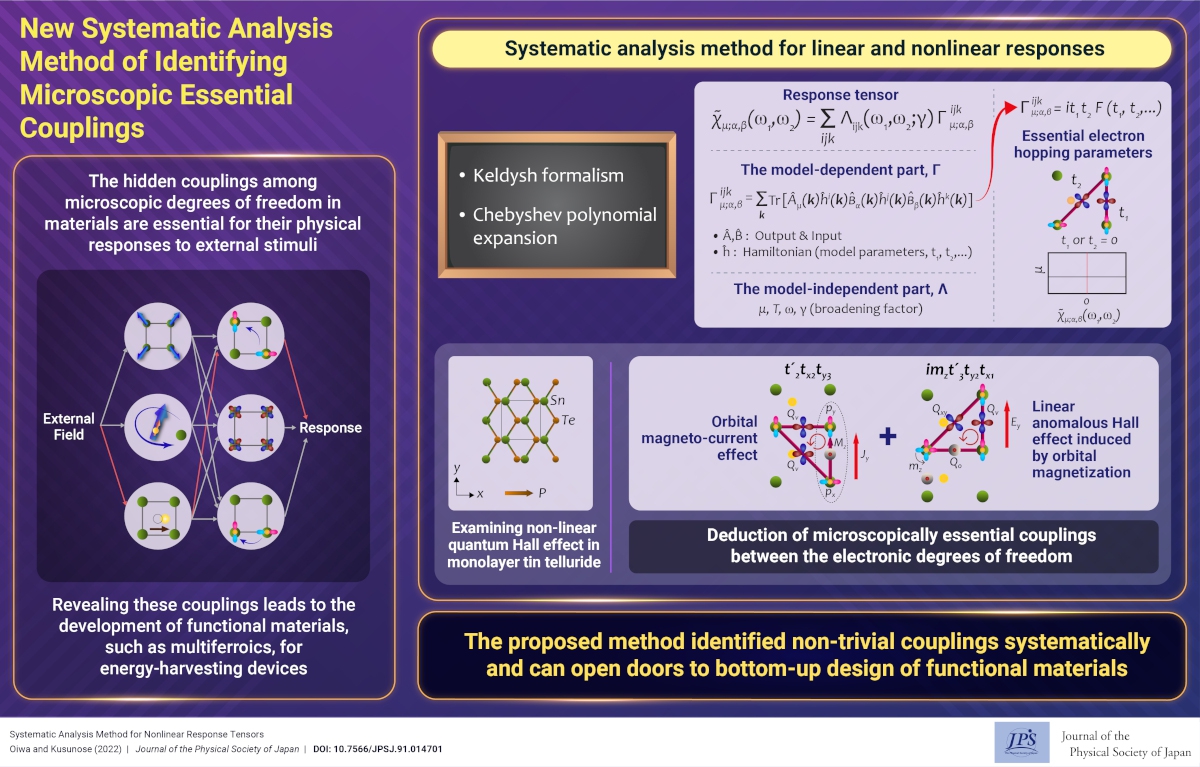New Systematic Analysis Method of Identifying Microscopic Essential Couplings
© The Physical Society of Japan
This article is on
Systematic Analysis Method for Nonlinear Response Tensors
(JPSJ Editors' Choice)
J. Phys. Soc. Jpn.
91,
014701
(2022)
.
We propose a systematic method of identifying essential model parameters for nonlinear response tensors. The analysis results reveal fundamental couplings in nontrivial responses and promote further development of multiferroic responses.

Discovering physical responses and elucidating their microscopic mechanisms are central subjects in condensed matter physics. Recently, various linear and nonlinear responses, such as the anomalous Hall effect under antiferromagnetic orderings and nonlinear optoelectronic transport, have been extensively investigated. These responses have been mainly analyzed theoretically by electronic-structure calculation, group-theoretical argument with electronic multipoles, and Berry curvature interpretation in the context of the topology of electronic states. These approaches have their own advantages: the electronic-structure calculation takes account of the complicated electronic band structures quantitatively, while the argument with the electronic multipoles can identify the relevant electronic degrees of freedom from the symmetry viewpoint.
However, in reality, the system contains numerous model parameters, making it difficult to determine the most important factor in various linear and nonlinear responses. Thus, identifying the essential parameters in the responses is significant to obtain a deeper understanding of multiferroic responses, and once determined, they provide a microscopic picture of the response. In other words, minimal couplings among the model parameters, such as electron hopping and spin-orbit coupling, and electric and/or magnetic order parameters are identified, and they provide a useful guideline for designing novel functional materials.
We proposed a systematic analysis method for linear and nonlinear responses that enables us to extract essential model parameters from a large number of parameters of a given theoretical model. Using the Keldysh formalism and Chebyshev polynomial expansion method, the response tensors are decomposed into model-independent and model-dependent parts; the latter is expressed as a power series of the Hamiltonian matrix and operators describing the external input and resultant response. By analyzing the low-order contributions in the model-dependent part analytically, we can identify essential parameters and deduce a microscopic picture of the response as a minimal coupling between the degrees of freedom associated with the essential parameters. We demonstrated our method by analyzing the nonlinear Hall effect in the ferroelectric SnTe monolayer and elucidated the significance of a second-neighbor diagonal hopping with an orbital exchange that always exists regardless of ferroelectric ordering.
The present method is applicable to a wide range of materials such as inorganic/organic molecules and quantum dots because it is not restricted to the periodicity of the crystal. Similarly, the present systematic analysis method reveals hidden couplings between transfer integrals, spin-orbit coupling, and order parameters in various materials, and is expected to provide a useful design guideline for future functional materials.
(Written by R. Oiwa on behalf of all authors)
Systematic Analysis Method for Nonlinear Response Tensors
(JPSJ Editors' Choice)
J. Phys. Soc. Jpn.
91,
014701
(2022)
.
Share this topic
Fields
Related Articles
-
Qualitative Changes in Kinetic Pathways Driven by Hydrodynamic Interactions in Dense Colloidal Suspensions
Cross-disciplinary physics and related areas of science and technology
Statistical physics and thermodynamics
Structure and mechanical and thermal properties in condensed matter
2025-4-18
Even in dense colloidal suspensions, where long-range hydrodynamic interactions are screened, near-field hydrodynamic interactions qualitatively influence the selection of kinetic pathways.
-
Exploring the Vibrant Interplay of Machine Learning and Physics
Cross-disciplinary physics and related areas of science and technology
Electron states in condensed matter
Elementary particles, fields, and strings
Mathematical methods, classical and quantum physics, relativity, gravitation, numerical simulation, computational modeling
Statistical physics and thermodynamics
Superconductivity
2025-3-13
This Journal of the Physical Society of Japan Special Topics edition explores how physics and machine learning complement each other and can solve unresolved problems in physics.
-
A Unified Theory of Topological Hall Effect
Electronic transport in condensed matter
2025-3-6
This paper presents a unified theoretical description for the topological Hall effect, covering the entire region from strong- to weak-coupling, extending its picture beyond the Berry phase.
-
Excitonic Insulators: Challenges in Realizing a Theoretically Predicted State of Matter
Electron states in condensed matter
Electronic transport in condensed matter
2025-3-3
The realization of an excitonic insulator can help in the establishment of a new electronic state in condensed matter physics, one that has the potential to exhibit novel electric, magnetic, and optical responses beyond those of conventional materials.
-
Exploring Materials without Data Exposure: A Bayesian Optimizer using Secure Computation
Cross-disciplinary physics and related areas of science and technology
Measurement, instrumentation, and techniques
2025-2-6
Secure computation allows the manipulation of material data without exposing them, thereby offering an alternative to traditional open/closed data management. We recently reported the development of an application that performs Bayesian optimization using secure computation.




